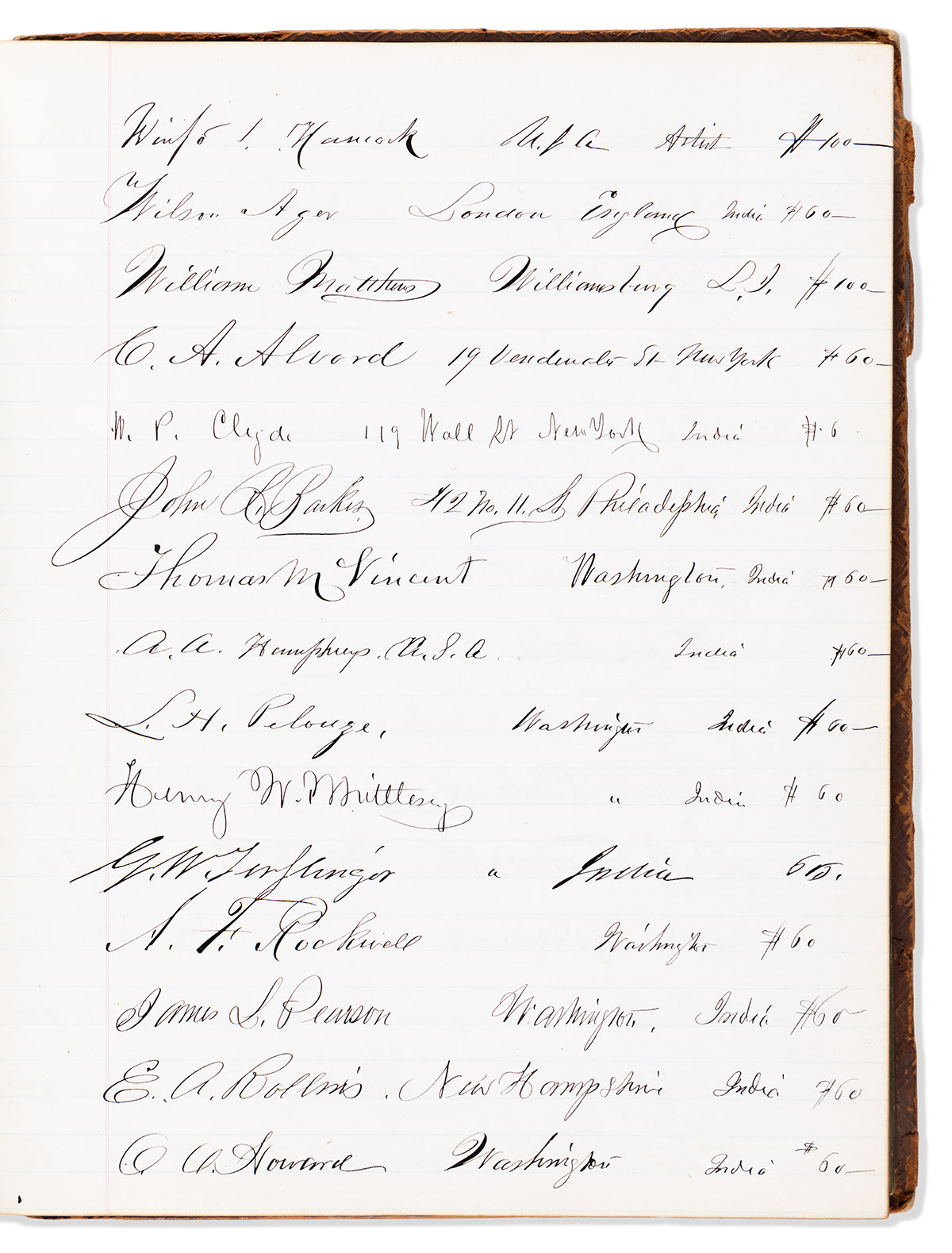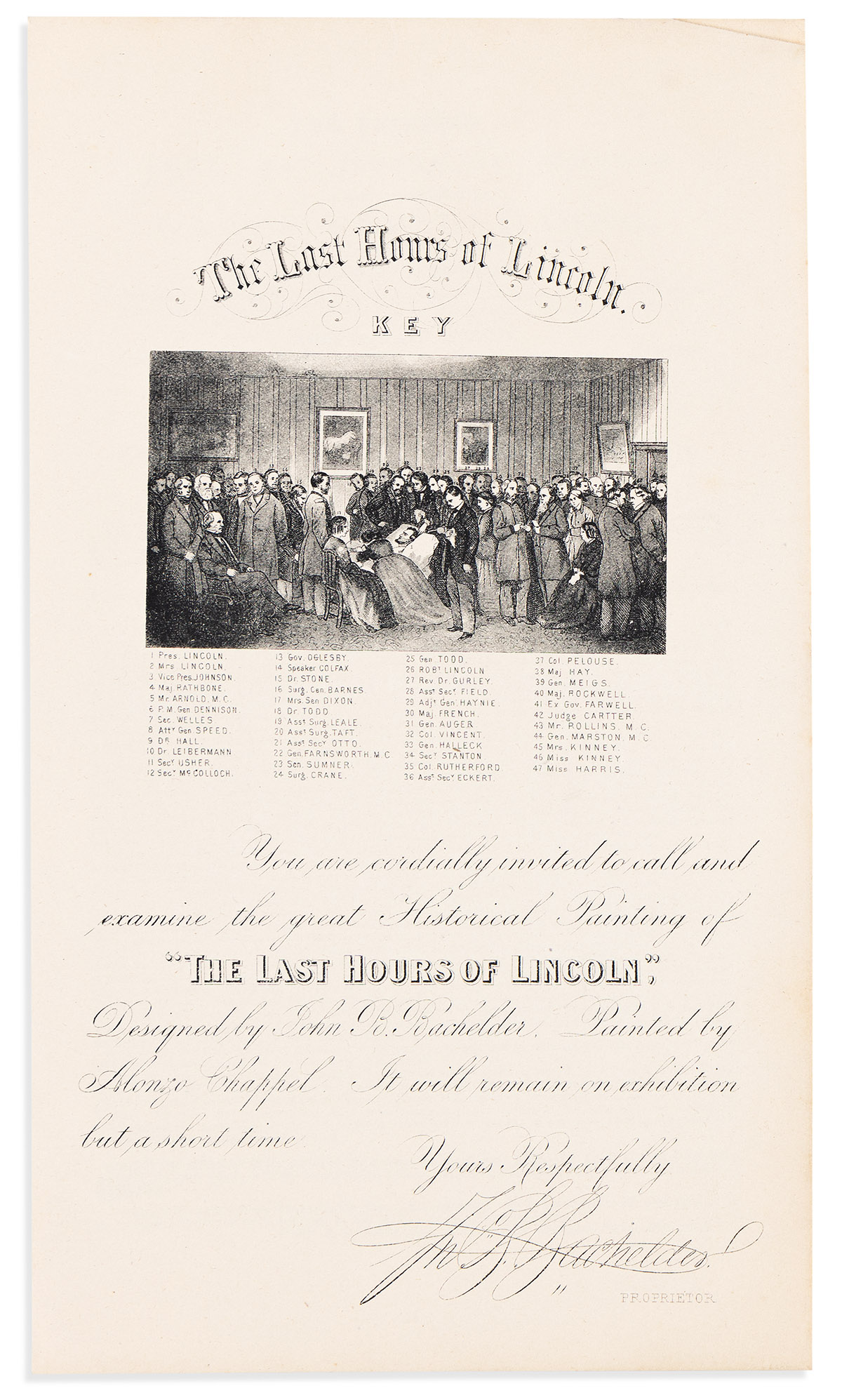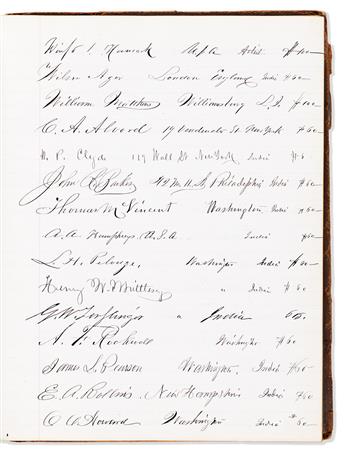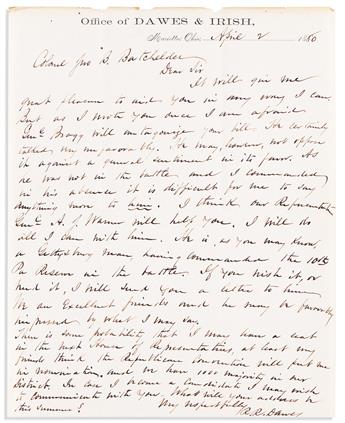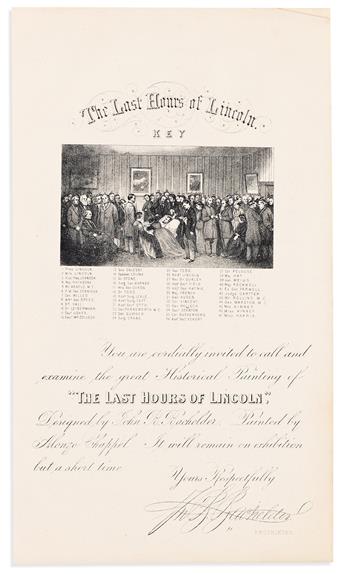Sale 2675 - Lot 192
Price Realized: $ 2,200
Price Realized: $ 2,750
?Final Price Realized includes Buyer’s Premium added to Hammer Price
Estimate: $ 3,000 - $ 4,000
(ABRAHAM LINCOLN.) Subscription book for J.B. Bachelder's engraving "The Last Hours of Abraham Lincoln," with related papers. 13 manuscript pages. 4to, original full calf, lacking backstrip, otherwise moderate wear; minimal wear to contents. With 14 letters and 3 related items, sleeved in a binder. Various places, 1865-1893
Additional Details
The New Hampshire artist John Badger Bachelder (1825-1894) accompanied the Army of the Potomac at several battles, and became a leading authority on the Battle of Gettysburg. After the Lincoln assassination, he also created an elaborate engraving of Lincoln's deathbed. He commissioned Brady photographs of those in attendance, and had the historical artist Alonzo Chappell paint the scene after his own design in 1868. The painting was then engraved and sold to subscribers: $60 for India proofs and $100 for artist proofs.
This subscription book records the names of 163 subscribers, their town of residence, and usually the price paid. Many of the early names were gathered in Washington; most of the later ones were gathered across Illinois, including Governor Richard Oglesby (depicted in the engraving). Many marquee subscribers are recorded in secretarial hands, presumably to inspire others. The first three names in the book are Ulysses S. Grant, Schuyler Colfax, and Treasury Secretary Hugh McCulloch; we suspect McCulloch signed his own name and added Grant and Colfax. They are followed by Edwin Stanton and Gideon Welles. Other apparently secretarial names include Robert Todd Lincoln, Oliver O. Howard, and Thaddeus Stevens. The volume also contains numerous original signatures, such as General Winfield Scott Hancock, and several of the bedside visitors who are depicted in the engraving such as Surgeon C.H. Crane.
Following the subscriber names are two signed testimonial notes describing how the Chappell painting was saved from the Chicago Fire while on exhibit at the Crosby Opera House in 1871. Its frame was secured to the wall, so a staffer cut it from the frame; it was the last work to be saved from the building "as the flames burst in the windows." The two men responsible for the rescue are also recorded on the subscription rolls to receive complimentary proofs.
Accompanying the subscription book are an unmounted albumen photograph of the Chappell painting on an easel, 6 x 10 inches; 2 copies of Bachelder's illustrated brochure and key for the painting's Washington exhibition, including subscription terms for the forthcoming engravings; and 14 letters to Bachelder on "The Last Hours of Lincoln," Gettysburg, and other topics, 1865-1893. Highlights of the correspondence include:
Union General Régis de Trobriand, a participant at the Battle of Gettysburg. Autograph Letter Signed, declining an invitation to meet at Gettysburg, and noting that the 3rd Michigan Infantry was "deployed as skirmishers across the field and peach orchard on my right" at the battle. New York, 27 October 1865.
Illinois Governor Richard J. Oglesby, a Lincoln deathbed attendee. Letter Signed, offering to send a photograph for use in the painting. Springfield, IL, 20 August 1866.
United States Representative Edward Henry Rollins of New Hampshire, another deathbed attendee. Autograph Letter Signed, offering to have his Brady photograph reshot as the negative was lost. Washington, 27 July 1869.
Colonel Louis Henry Pelouze, another attendee. Autograph Letter Signed offering the correct spelling of his name. Washington, 25 January 1869.
General Montgomery Cunningham Meigs, another attendee, doing the same. Washington, 21 January 1869.
Colonel George V. Rutherford, another attendee, explaining that "the V in my signature is for no name but simply an initial," and describing his plans to see the painting on exhibition in Springfield. Quincy, IL, 26 January 1869.
Colonel Rufus R. Dawes. Autograph Letter Signed regarding Gettysburg memorial plans: "Gen'l [Congressman Edward] Bragg will antagonize your bill. He certainly talked very unfavorably. . . . As he was not in the battle and I commanded in his absence, it is difficult for me to say anything more to him." Marietta, OH, 2 April 1880.
Colonel Hiram Berdan. Autograph Letter Signed: "Will be ready to follow Genl Sickles with a few appropriate remarks on the gallant duels of the sharpshooters." Washington, 27 May 1892.
Author George William Curtis. Letter Signed, asking "whether the bodies of the Confederate soldiers buried at Gettysburg were subsequently removed to the Southern states . . . that they might not lie in northern soil?" Ashfield, MA, 22 July 1888.
This subscription book records the names of 163 subscribers, their town of residence, and usually the price paid. Many of the early names were gathered in Washington; most of the later ones were gathered across Illinois, including Governor Richard Oglesby (depicted in the engraving). Many marquee subscribers are recorded in secretarial hands, presumably to inspire others. The first three names in the book are Ulysses S. Grant, Schuyler Colfax, and Treasury Secretary Hugh McCulloch; we suspect McCulloch signed his own name and added Grant and Colfax. They are followed by Edwin Stanton and Gideon Welles. Other apparently secretarial names include Robert Todd Lincoln, Oliver O. Howard, and Thaddeus Stevens. The volume also contains numerous original signatures, such as General Winfield Scott Hancock, and several of the bedside visitors who are depicted in the engraving such as Surgeon C.H. Crane.
Following the subscriber names are two signed testimonial notes describing how the Chappell painting was saved from the Chicago Fire while on exhibit at the Crosby Opera House in 1871. Its frame was secured to the wall, so a staffer cut it from the frame; it was the last work to be saved from the building "as the flames burst in the windows." The two men responsible for the rescue are also recorded on the subscription rolls to receive complimentary proofs.
Accompanying the subscription book are an unmounted albumen photograph of the Chappell painting on an easel, 6 x 10 inches; 2 copies of Bachelder's illustrated brochure and key for the painting's Washington exhibition, including subscription terms for the forthcoming engravings; and 14 letters to Bachelder on "The Last Hours of Lincoln," Gettysburg, and other topics, 1865-1893. Highlights of the correspondence include:
Union General Régis de Trobriand, a participant at the Battle of Gettysburg. Autograph Letter Signed, declining an invitation to meet at Gettysburg, and noting that the 3rd Michigan Infantry was "deployed as skirmishers across the field and peach orchard on my right" at the battle. New York, 27 October 1865.
Illinois Governor Richard J. Oglesby, a Lincoln deathbed attendee. Letter Signed, offering to send a photograph for use in the painting. Springfield, IL, 20 August 1866.
United States Representative Edward Henry Rollins of New Hampshire, another deathbed attendee. Autograph Letter Signed, offering to have his Brady photograph reshot as the negative was lost. Washington, 27 July 1869.
Colonel Louis Henry Pelouze, another attendee. Autograph Letter Signed offering the correct spelling of his name. Washington, 25 January 1869.
General Montgomery Cunningham Meigs, another attendee, doing the same. Washington, 21 January 1869.
Colonel George V. Rutherford, another attendee, explaining that "the V in my signature is for no name but simply an initial," and describing his plans to see the painting on exhibition in Springfield. Quincy, IL, 26 January 1869.
Colonel Rufus R. Dawes. Autograph Letter Signed regarding Gettysburg memorial plans: "Gen'l [Congressman Edward] Bragg will antagonize your bill. He certainly talked very unfavorably. . . . As he was not in the battle and I commanded in his absence, it is difficult for me to say anything more to him." Marietta, OH, 2 April 1880.
Colonel Hiram Berdan. Autograph Letter Signed: "Will be ready to follow Genl Sickles with a few appropriate remarks on the gallant duels of the sharpshooters." Washington, 27 May 1892.
Author George William Curtis. Letter Signed, asking "whether the bodies of the Confederate soldiers buried at Gettysburg were subsequently removed to the Southern states . . . that they might not lie in northern soil?" Ashfield, MA, 22 July 1888.
Exhibition Hours
Exhibition Hours
Aliquam vulputate ornare congue. Vestibulum maximus, libero in placerat faucibus, risus nisl molestie massa, ut maximus metus lectus vel lorem.



